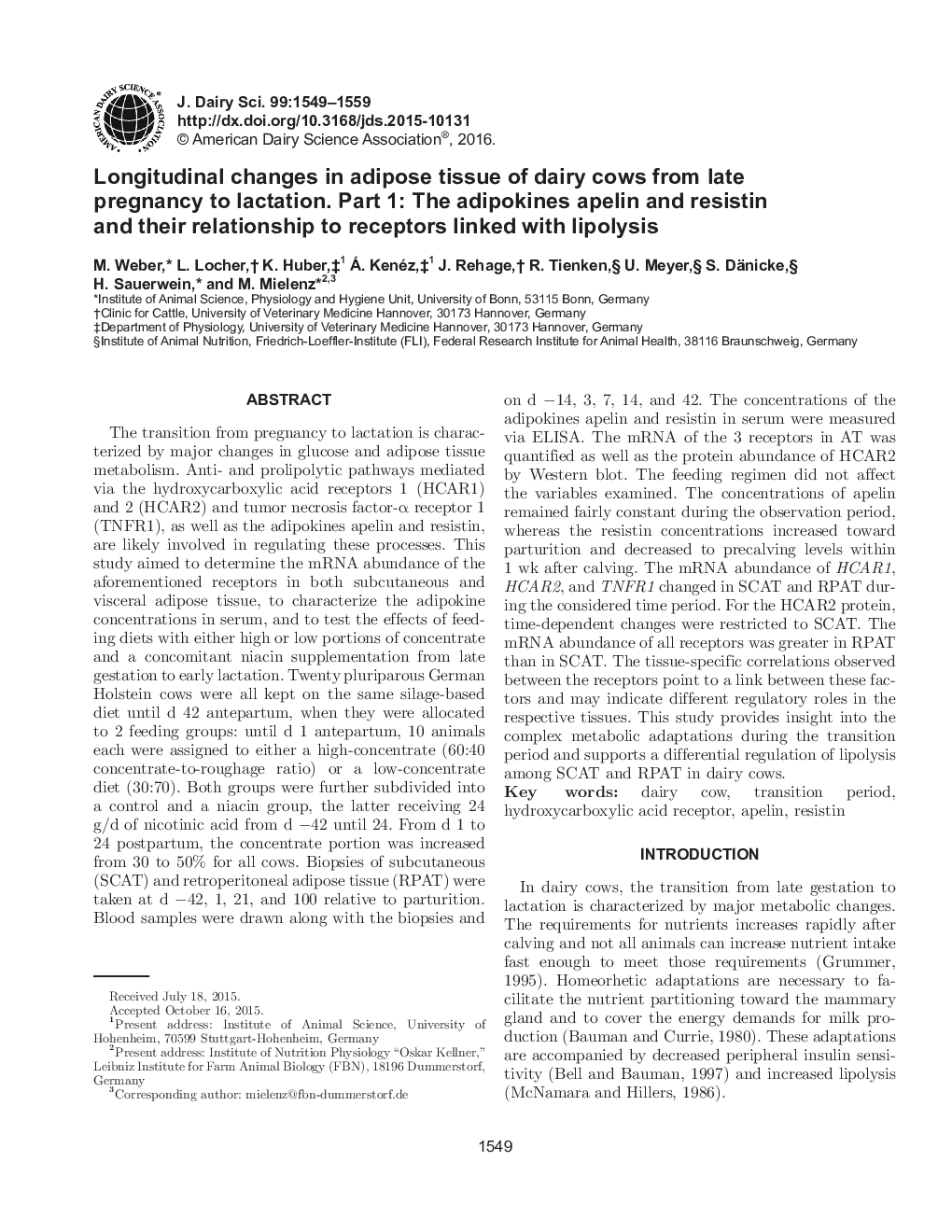| کد مقاله | کد نشریه | سال انتشار | مقاله انگلیسی | نسخه تمام متن |
|---|---|---|---|---|
| 10973586 | 1108016 | 2016 | 11 صفحه PDF | دانلود رایگان |
عنوان انگلیسی مقاله ISI
Longitudinal changes in adipose tissue of dairy cows from late pregnancy to lactation. Part 1: The adipokines apelin and resistin and their relationship to receptors linked with lipolysis
ترجمه فارسی عنوان
تغییرات طولی در بافت چربی گاوهای شیری از بارداری تا حاملگی تا شیردهی. قسمت 1: آدپیوکین ها آپین و مقاومت درمانی و ارتباط آنها با گیرنده های مرتبط با لیپولیز
دانلود مقاله + سفارش ترجمه
دانلود مقاله ISI انگلیسی
رایگان برای ایرانیان
کلمات کلیدی
گاو شیری، دوره گذار، هیدروکسی کربوکسیلیک اسید گیرنده، آپلین مقاومت
موضوعات مرتبط
علوم زیستی و بیوفناوری
علوم کشاورزی و بیولوژیک
علوم دامی و جانورشناسی
چکیده انگلیسی
The transition from pregnancy to lactation is characterized by major changes in glucose and adipose tissue metabolism. Anti- and prolipolytic pathways mediated via the hydroxycarboxylic acid receptors 1 (HCAR1) and 2 (HCAR2) and tumor necrosis factor-α receptor 1 (TNFR1), as well as the adipokines apelin and resistin, are likely involved in regulating these processes. This study aimed to determine the mRNA abundance of the aforementioned receptors in both subcutaneous and visceral adipose tissue, to characterize the adipokine concentrations in serum, and to test the effects of feeding diets with either high or low portions of concentrate and a concomitant niacin supplementation from late gestation to early lactation. Twenty pluriparous German Holstein cows were all kept on the same silage-based diet until d 42 antepartum, when they were allocated to 2 feeding groups: until d 1 antepartum, 10 animals each were assigned to either a high-concentrate (60:40 concentrate-to-roughage ratio) or a low-concentrate diet (30:70). Both groups were further subdivided into a control and a niacin group, the latter receiving 24 g/d of nicotinic acid from d â42 until 24. From d 1 to 24 postpartum, the concentrate portion was increased from 30 to 50% for all cows. Biopsies of subcutaneous (SCAT) and retroperitoneal adipose tissue (RPAT) were taken at d â42, 1, 21, and 100 relative to parturition. Blood samples were drawn along with the biopsies and on d â14, 3, 7, 14, and 42. The concentrations of the adipokines apelin and resistin in serum were measured via ELISA. The mRNA of the 3 receptors in AT was quantified as well as the protein abundance of HCAR2 by Western blot. The feeding regimen did not affect the variables examined. The concentrations of apelin remained fairly constant during the observation period, whereas the resistin concentrations increased toward parturition and decreased to precalving levels within 1 wk after calving. The mRNA abundance of HCAR1, HCAR2, and TNFR1 changed in SCAT and RPAT during the considered time period. For the HCAR2 protein, time-dependent changes were restricted to SCAT. The mRNA abundance of all receptors was greater in RPAT than in SCAT. The tissue-specific correlations observed between the receptors point to a link between these factors and may indicate different regulatory roles in the respective tissues. This study provides insight into the complex metabolic adaptations during the transition period and supports a differential regulation of lipolysis among SCAT and RPAT in dairy cows.
ناشر
Database: Elsevier - ScienceDirect (ساینس دایرکت)
Journal: Journal of Dairy Science - Volume 99, Issue 2, February 2016, Pages 1549-1559
Journal: Journal of Dairy Science - Volume 99, Issue 2, February 2016, Pages 1549-1559
نویسندگان
M. Weber, L. Locher, K. Huber, Á. Kenéz, J. Rehage, R. Tienken, U. Meyer, S. Dänicke, H. Sauerwein, M. Mielenz,
